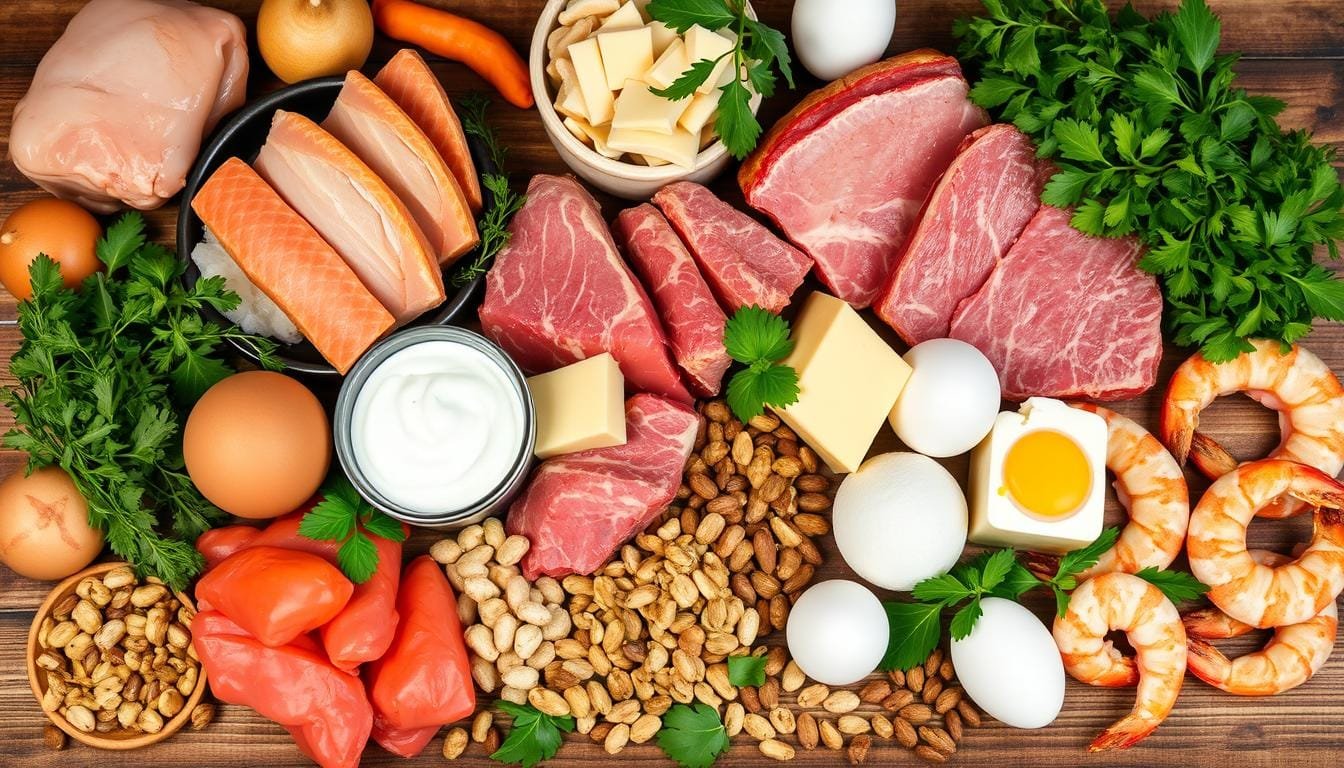Protein is key for our health. It helps with cell structure, immune function, and movement. It also supports chemical reactions and hormone synthesis. The daily protein need is 0.36 grams per pound of body weight.
Many of us find it hard to get enough protein. This article will show you 12 great sources of protein. You’ll find both animal and plant-based options to keep your diet balanced and nutritious.
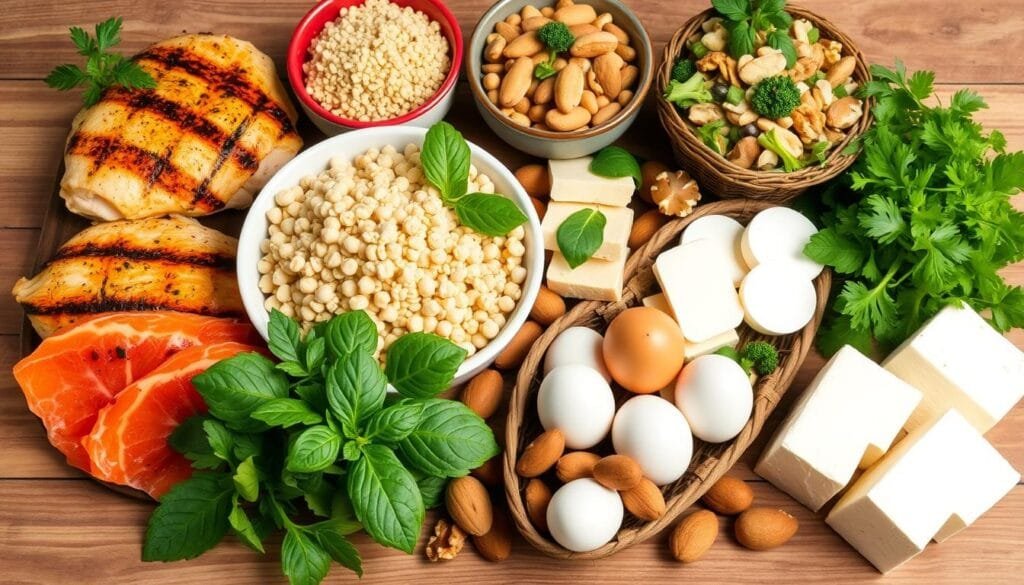
Key Takeaways
- Protein is essential for various bodily functions and supports a healthy weight.
- The recommended dietary allowance for protein is 0.36 grams per pound of body weight.
- Incorporating a variety of protein-rich foods can help you meet your daily needs.
- Both animal and plant-based sources offer excellent options for a balanced diet.
- Combining different protein sources can maximize the benefits of this important nutrient.
Understanding Protein’s Role in Your Diet
Protein is key for our bodies, playing a big role in many functions. It’s made of amino acids, with nine essential ones we must get from food. These amino acids help build muscles and regulate hormones.
Essential Amino Acids and Their Functions
The nine essential amino acids are histidine, isoleucine, leucine, lysine, methionine, phenylalanine, threonine, tryptophan, and valine. Each amino acid has its own job in the body. For example:
- Histidine: Helps make red and white blood cells and keeps nerve cells safe.
- Isoleucine: Helps muscles recover and gives energy, and is also important for hemoglobin.
- Leucine: Boosts muscle growth and repair.
- Lysine: Helps make carnitine, which is key for energy and fat use.
Daily Protein Requirements
The daily protein need is 0.36 grams per pound of body weight. This can change based on how active you are and your health. For a 140-pound person, that’s about 50 grams of protein daily. A 200-pound person might need around 70 grams.
Benefits of High-Protein Foods
Eating a variety of high-protein foods has many benefits. For example:
- It helps build and keep muscles.
- It makes you feel full, which can help with weight control.
- It keeps blood sugar stable.
- It strengthens the immune system.
Knowing how important protein is and what amino acids do helps us make better food choices. This supports our health and well-being.
Good Sources of Protein From Animal Products
Animal-based proteins are key to a healthy diet. They give us essential amino acids. These help grow and repair muscles, boosting our overall health.
Eggs are a top choice, with 6.3 grams of protein per large egg. They also have important vitamins and minerals for our health.
Lean meats like chicken breast are great too. A half-breast of grilled chicken has 26.7 grams of protein. Lean beef also offers 24.6 grams of protein per 3-ounce serving.
Fatty fish like salmon and cod are protein-rich. A salmon fillet has up to 30.5 grams of protein. Cod fillets have an impressive 41 grams.
Dairy products like cottage cheese and Greek yogurt are also good for protein. Cottage cheese has 28 grams of protein per cup. Greek yogurt provides 19.9 grams in a 7-ounce container.
| Food | Protein (g per 100g) |
|---|---|
| Grilled Chicken Breast | 32.0 |
| Grilled Beef | 21.7 |
| Cooked Rabbit | 29.2 |
| Boiled Eggs | 12.6 |
| 2% Milk | 3.23 |
| Brazilian Soft Cheese | 24.2 |
Adding lean meats, fish, eggs, and dairy to our diet is smart. It ensures we get a variety of high-quality, animal-based proteins. These support our health and fitness goals.
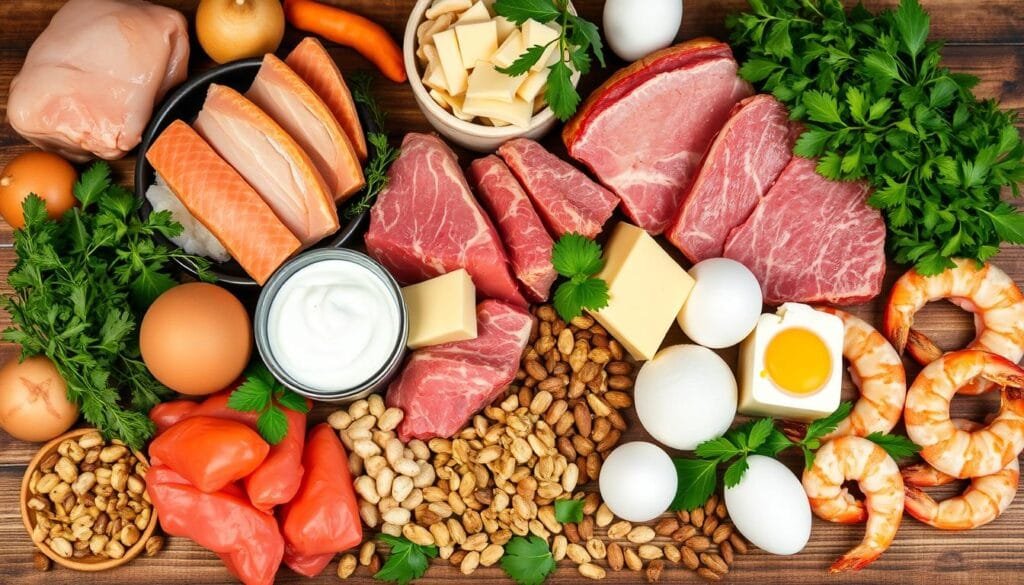
Plant-Based Protein Powerhouses
Exploring plant-based nutrition reveals a wealth of protein-rich foods. These options are perfect for a healthier diet. From legumes to seeds, the plant world offers many choices to increase protein intake.
Legumes and Pulses
Legumes like lentils, chickpeas, and beans are packed with protein. Lentils have 18 grams of protein per cooked cup. Chickpeas offer 15 grams per cup. These foods are not only high in protein but also rich in fiber, aiding digestion and gut health.
Nuts and Seeds
Nuts and seeds are also great sources of plant-based proteins. Almonds have 6 grams of protein per ounce. Hemp seeds provide 10 grams of complete protein per 3-tablespoon serving. They are also rich in healthy fats, fiber, and essential vitamins and minerals.
Whole Grains and Pseudocereals
Looking beyond regular grains, we find pseudocereals like quinoa and amaranth. Quinoa, known as a “supergrain,” has 8 grams of protein per cooked cup. It’s a complete protein, meaning it has all essential amino acids. Whole grains like spelt and teff also offer a lot of protein, with about 10-11 grams per cooked cup.
By adding these plant-based proteins, vegan protein sources, and legumes to our diets, we gain many nutritional benefits. We can enjoy a variety of dishes, from lentil stews to quinoa bowls. The possibilities are endless for those looking to nourish their bodies with plant-based foods.
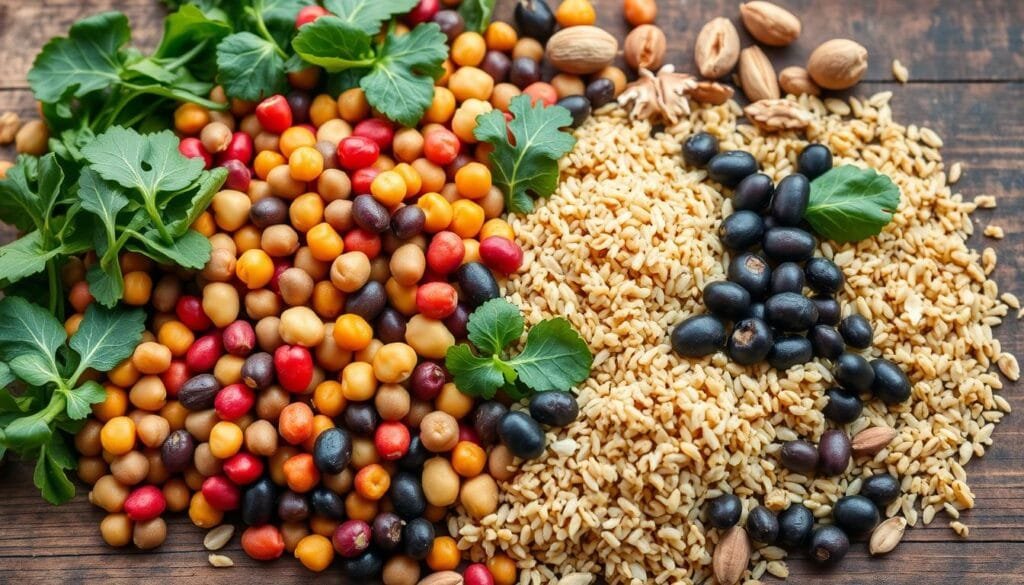
Combining Protein Sources for Maximum Benefits
A balanced diet is key for good health. It’s important to eat a variety of protein sources. This way, we get all the nutrients we need and a full amino acid profile.
For example, eating whole grains like quinoa with legumes like lentils gives us all nine essential amino acids. This is great for vegetarians and vegans. It helps them get enough amino acids without eating meat.
Mixing animal and plant proteins is also good. Try adding eggs to a veggie stir-fry or Greek yogurt with nuts and seeds. These combos give us lots of vitamins, minerals, and antioxidants. They help us eat a balanced diet and enjoy nutrient synergy.
“A well-planned vegetarian diet can provide all necessary vitamins, minerals, and amino acids for the body.”
Being smart about protein combinations helps us get the most from our food. This way, we meet all our nutritional needs. It’s the best way to make our diet healthy and balanced.
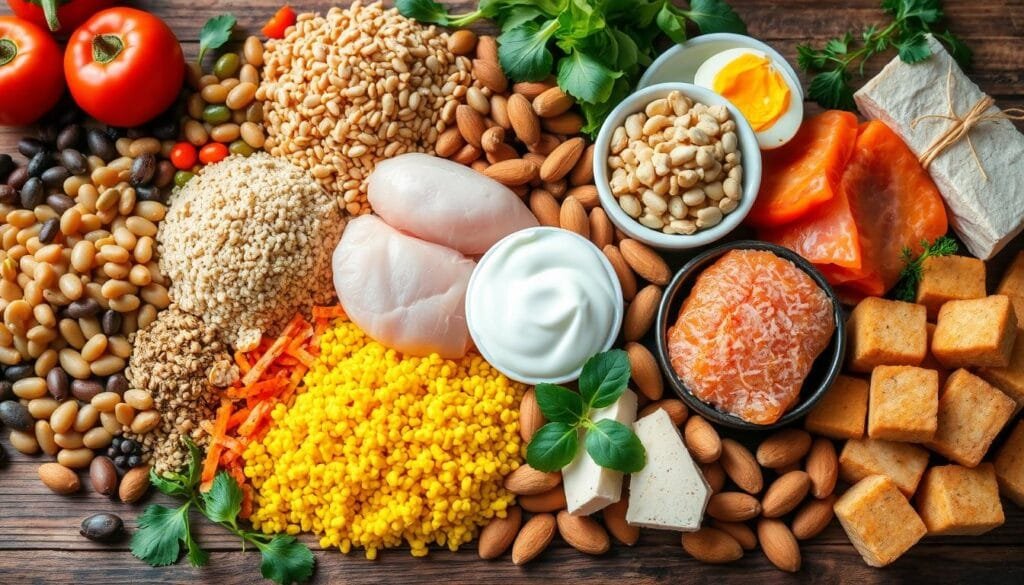
Vary your protein sources and try different mixes. This will help you find what’s best for you. By doing this, you’ll be on your way to a healthier, more enjoyable diet.
Conclusion
Eating a variety of protein-rich foods is key for good health. Both animal-based and plant-based proteins have their own benefits. They help us create a balanced diet.
Knowing how much protein we need and finding different sources is important. This way, we can improve our healthy eating habits. It helps us feel better overall.
It doesn’t matter if you like meat, dairy, legumes, nuts, or grains. The main thing is to eat a variety of foods. This ensures we get all the nutrients our bodies need.
By choosing wisely and mixing different proteins, we support our health and fitness goals. It’s easy to make protein-rich meals that are good for us.
Changing our diet for the better is a journey, not a goal to reach right away. Adopting a protein-rich diet and balanced eating can greatly benefit us. It’s a step towards a healthier life.
FAQ
What is the role of protein in our diet?
Protein is key for our health. It helps build cells, supports our immune system, and aids in movement. It also plays a role in chemical reactions and hormone production.
What is the recommended dietary allowance (RDA) for protein?
The RDA for protein is 0.36 grams per pound of body weight. But, your needs might change based on how active you are and your health history.
How does consuming protein benefit us?
Eating protein helps you feel full and satisfied. This can help you maintain a healthy weight.
What are some good sources of animal-based proteins?
Eggs, chicken, lean beef, fish, and dairy are great for animal-based proteins. They offer a complete protein.
What are some good plant-based protein options?
Legumes, nuts, seeds, whole grains, and soy products are top plant-based proteins. They provide essential amino acids.
How can we combine protein sources for maximum benefits?
Mixing different proteins boosts nutrient intake and amino acid balance. For example, pairing whole grains with legumes makes a complete protein.
